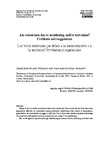Are Corestones Due to Weathering and/or Tectonism? Problems and Suggestions

View/
Use this link to cite
http://hdl.handle.net/2183/27855
Except where otherwise noted, this item's license is described as Atribución-CompartirIgual 4.0 Internacional (CC BY-SA 4.0)
Collections
Metadata
Show full item recordTitle
Are Corestones Due to Weathering and/or Tectonism? Problems and SuggestionsAlternative Title(s)
Los bolos residuales ¿se deben a la meteorización o a la tectónica? Problemas y sugerenciasDate
2020-12-28Citation
Twidale, C. R., & Vidal Romaní, J. R. (2020). Are corestones due to weathering and/or tectonism? Problems and suggestions. Cadernos do Laboratorio Xeolóxico de Laxe. Revista de Xeoloxía Galega e do Hercínico Peninsular, 42, 29-52. https://doi.org/10.17979/cadlaxe.2020.42.0.7268
Abstract
[Abstract] Many of the so-called corestones have been developed from rocky blocks that have been apparently affected by subsurface physicochemical weathering that results in lamination, granulation, and eventually a puggy or stiff clay. The truth is that weathering takes advantage of a previous deformation structure and does not create it by weathering. [Resumen] Muchas de los llamados bolos residuales se han desarrollado a partir de bloques rocosos que han sido aparentemente afectados por la meteorización fisicoquímica del subsuelo que da lugar a la laminación, la granulación y, finalmente, a una arcilla rugosa o rígida. Lo cierto es que el desgaste aprovecha una estructura de deformación previa y no la crea por el desgaste.
Keywords
Granitic geomorphology
Weathering processes
Blocks
Shearing
Residual cores
Geomorfología granítica
Procesos de meteorización
Bloques
Cizallamiento
Núcleos residuales
Weathering processes
Blocks
Shearing
Residual cores
Geomorfología granítica
Procesos de meteorización
Bloques
Cizallamiento
Núcleos residuales
Editor version
Rights
Atribución-CompartirIgual 4.0 Internacional (CC BY-SA 4.0)
ISSN
2173-6936
0213-4497
0213-4497






